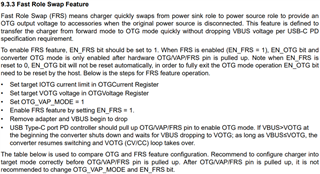Other Parts Discussed in Thread: BQ25703A
Hi,
Let me apologize first, as it is going to be a long questionnaire.
Planning to use BQ5730 as a 3S1P/3S2P charger.
It is not a USB/PD application, but purely a battery charging and discharging application- also enquiring if we can hack the OTG/FRS feature of the PD 3.0 it supports.
- We are trying to charge and discharge through the same VBUS. I understand that BQ25730 can swap its role from a power sink to a power source as soon as the external DC adapter-in loses its power when it is in FRS mode. I also understand that the output voltage and current at VBUS will be as per the value written into the corresponding registers of BQ25730. Our application is around 12V (can be between 12V & 13V) My first question is that if BQ25730 can generate such a voltage (say, between 12V&13V) at its VBUS from a 3S battery (12.6V)? or, is it limited to typical 5V/9V/15V/20V?
- I see that BQ25703A and BQ25730 both incorporate OTG support. BQ25703A starts sourcing at VBUS in 10ms after the conditions (section 8.3.3 in DS) are met, but BQ25730 takes 15ms to start sourcing at VBUS after the listed conditions (section 9.3.9 in DS) are met. Only BQ25730 supports Fast Role Swap- Isn't it contradictory that the device without FRS sources quicker? what advantage do we get with FRS-enabled BQ25730 in the context of higher sourcing delay?
- As I mentioned before, this application has nothing to do with USB or USB power delivery, hence no PD controllers and CC pins. So in order to utilize FRS or to be in FRS ready mode always, can you please confirm if the below steps taken in design are sufficient?
a) OTG/VAP/FRS pin permanently set high with a pullup resistor.
b) Setting target IOTG current limit & VOTG voltage in OTGCurrent Register & OTGVoltage Register respectively by host MCU during initialization.
c) Writing OTG_VAP_MODE=1b & EN_FRS BIT=1b by host MCU during initialization.
d) Waiting for the DC-in at VBUS to drop in order to source set voltage at VBUS pin from the battery (in forward mode) / Waiting for DC-in at the VBUS to charge the battery while it is in sinking mode - Does enabling charge termination by the host, once the battery is full, have any impact on FRS?
- This is regarding the charging of Battery- How does BQ25730 stop charging when host tries to terminate charging either by setting CHRG_INHIBIT or by writing zero to charge current()? Is it by turning off BATFET off? will the VSYS have any impact? will it still drive the load connected to VSYS?
- How does the charger charge the battery and at the same time, make sure that the battery is not supplementing the system (discharging) in normal charging mode (no supplementation)? Does the voltage difference before & after BATFET ensure current flow is towards the battery only while it is charging? If that is the case, how does NVDC work when the battery is still charging (as it will still have the same voltage difference, yet have to discharge the battery)?
Thanks and regards
Abin



